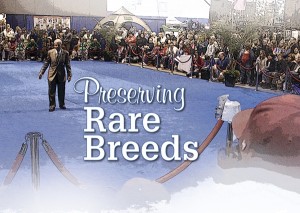Preserving Rare Breeds
Click here to read the complete article
 By William Given
By William Given
A dog breed does not “simply appear.” It comes into being because people see the merit in a certain type of dog capable of performing a specific role, whether hunting or herding, guard work or pest control, or even companionship. These people (breeders) often spend many years studying the practical application of canine genetics and breeding to improve the dog’s conformation and working abilities and to purify and set type. If they fail to achieve their goal, the stock dies off and the breed does not become established. If they are successful, then the dog’s instincts become fixed and type becomes set, and they will have developed a breed. Presumably, the breed should then exist forever.
We should take a couple of examples of dog breeds which are little known, even to history. Here on the North American continent, a number of breeds have gone extinct or, if not extinct, none have been seen for a sufficient time to make it appear so. One is the Mexican Hairless. This dog was registered by the American Kennel Club in the early days of the club’s existence. It was recognized much earlier, in fact, than was the Chihuahua.
The Chihuahua and the Xoloitzcuintli are considered to have originated with the Aztecs before the conquest by Cortez. The Xolo is also a hairless dog, but is noticeably larger than the Mexican Hairless is, or was. Why should the Xolo have survived and not the Mexican Hairless?
Except for the possibility that the Chihuahua and the Xolo were truly Indian dogs, only one Indian dog has survived to modern times. This is the Tahltan Bear Dog of northern Canada. It existed as recently as 50 years ago, but is now believed extinct. It is, or was, a short, fox-like dog with long straight hair, bat ears, and an 8- to 10 inch-long tail of extraordinary thickness.
Most dogs of the far North have caught on well in the southerly temperate zone climates. The Tahltan Bear Dog failed to do. Similarly, the Eskimo Dog of Greenland and the Eastern Canadian Artic Dog appear to be on the verge of extinction.
By the numbers
Click here to read the complete article

Short URL: https://caninechronicle.com/?p=198114
Comments are closed











